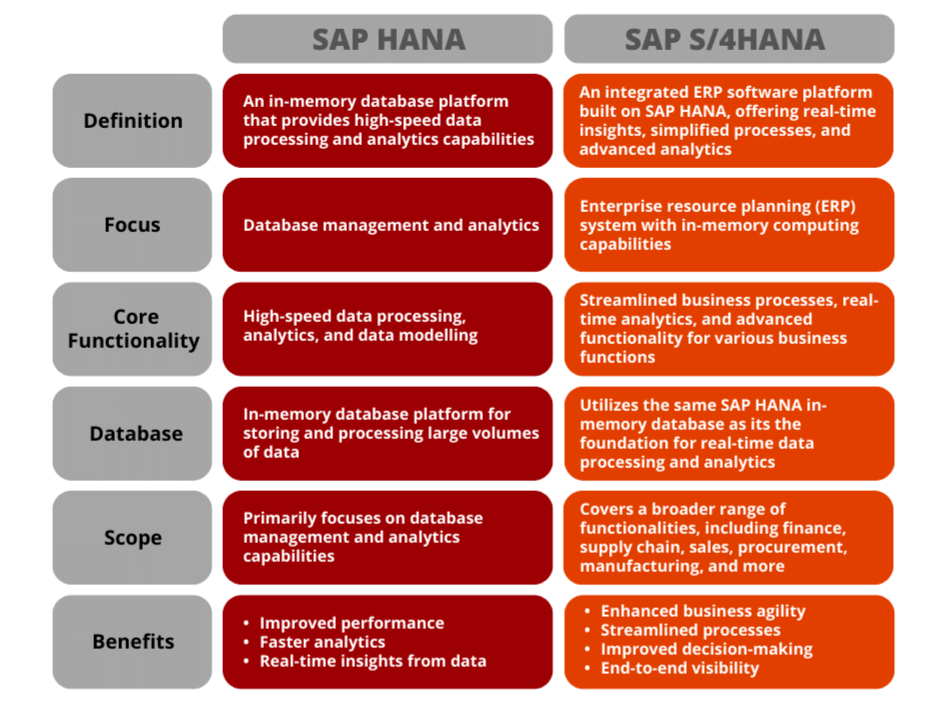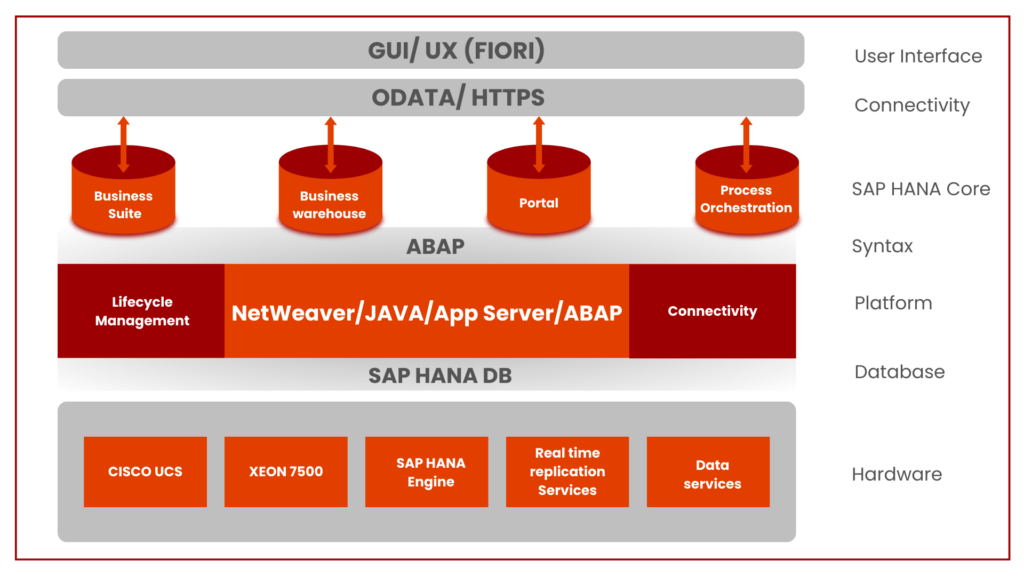Are you interested in taking your business to the next level by embracing digital technologies?
But hesitant and concerned that the digital transformation in your sector can have a negative effect on your business? Or perhaps you’re concerned about the difficulty, or security of the migrating procedure.
Get rid of all your worries with the help of SAP S/4HANA.
SAP S/4HANA is a next-generation, intelligent ERP system developed by SAP. It combines real-time data processing, advanced analytics, and streamlined processes to enable businesses to make faster, and more informed decisions.
Let’s explore more about SAP S/4HANA and its architecture in this blog!
Defining SAP S/4HANA
SAP S/4HANA is an ERP business suite that allows companies to perform real-time transactions and analysis of business data. It is based on the SAP HANA in-memory database and is central to SAP’s digital transformation strategy.
The terms SAP HANA and SAP S/4HANA, might sound the same, but it’s not. If you are confused on what’s the difference between them, then here is an overview of SAP HANA and SAP S/4HANA.
Difference between SAP HANA and SAP S/4HANA
Architecture of SAP S/4HANA
SAP S/4HANA is a revolutionary enterprise resource planning (ERP) system that has transformed the way businesses operate. Its architecture is the backbone of the system, providing a solid foundation for efficient business processes.
The architecture of SAP S/4HANA is composed of various layers, each with its own specific functions. At the bottom layer, we have the database layer, which stores all the data used by the system. Above the database layer, we have the application layer, which contains the business logic and processes the data. The third layer is the presentation layer, which provides the user interface for the system.
The central components of the SAP S/4HANA architecture include the SAP HANA database (Primarily enforced in Database layer), the SAP NetWeaver Application Server (Present in Application layer), and the SAP Fiori user interface (Incorporated in Presentation layer).
Let’s take a deep dive into the building blocks of SAP S/4HANA Architecture!!
Building Blocks of SAP S/4HANA Architecture
-
SAP HANA Database
The SAP S/4HANA architecture’s core element is the SAP HANA database layer. It functions as a high-performance, in-memory database for storing and processing data in real-time. Organizations evaluate and come to informed conclusions through the HANA database layer’s ability to manage enormous amounts of data and provide fast access to information.
It enables sophisticated features including machine learning, predictive analytics, and spatial processing. A solid foundation for executing S/4HANA applications and accelerating digital transformation with speed, agility, and scalability is provided by the HANA database layer’s seamless integration with other architectural layers.
-
SAP NetWeaver
By acting as the integration and application platform, SAP NetWeaver is essential to the SAP S/4HANA architecture. It enables easy data exchange between SAP S/4HANA and other systems, guaranteeing data consistency and facilitating efficient business operations.
To improve the system’s general functionality and interoperability, NetWeaver offers services including application servers, integration capabilities, security, and user management.
-
SAP Fiori
SAP Fiori is a user interface (UI) that offers a contemporary and simple user experience in the SAP S/4HANA architecture. Users can effectively complete work across devices and get pertinent information using role-based Fiori applications (like academic advisor, accounts payable accountant, etc…). It streamlines and simplifies interactions, boosting productivity and user satisfaction.
-
Advanced Business Application Programming (ABAP)
The ABAP layer in SAP S/4HANA architecture is a crucial component that supports customizations, enhancements, and development of applications. It sits on top of the underlying database layer and acts as an interpreter between the user interface and the database.
ABAP allows developers to create custom forms, generate reports, integrate with external systems through interfaces, migrate data using conversions, enhance standard functionality, and automate business processes with workflows using FRICE-W (Forms, Reports, Interfaces, Conversions, Enhancements and Workflows). ABAP’s versatility and integration capabilities make it a crucial tool for customizing and extending SAP solutions to meet specific business requirements.
-
OData
The SAP OData layer in SAP S/4HANA architecture enables the creation and consumption of standardized APIs for data access and integration. It serves as a middleware that allows seamless communication between different systems, applications, and devices.
It exposes data from the underlying S/4HANA system in a structured manner, providing a uniform and consistent interface for data retrieval, manipulation, and exchange. It enables organizations to leverage modern web technologies and enables the development of innovative solutions that can consume and interact with SAP S/4HANA data in a flexible and efficient manner.
Final Thought
Digital transformation is no longer an option but a necessity for businesses to stay competitive in today’s dynamic marketplace. SAP S/4HANA provides a comprehensive solution that overcomes many of the challenges associated with digital transformation.
So, are you ready to take the first step towards digital transformation with SAP S/4HANA?
Here is your transformation partner, Kaar Tech.
With decades of expertise, KaarTech has successfully launched 2500+ SAP projects with 350+ happy clients and has competence in practically every area of business and established its SAP S/4HANA, SAP SuccessFactors, and SAP Ariba portfolios.
Do contact us for further information.
FAQ’s
What is SAP S/4HANA?
SAP S/4HANA is an intelligent ERP system developed by SAP, designed for real-time transactions, data analysis, and streamlined business processes.
What is the difference between SAP HANA and SAP S/4HANA?
SAP HANA is an in-memory database platform, while SAP S/4HANA is an integrated ERP system built on SAP HANA, providing real-time insights and streamlined business processes.
How does the SAP HANA database layer benefit SAP S/4HANA?
The SAP HANA database layer powers real-time data processing, analytics, and insights, forming the foundation for SAP S/4HANA’s applications and digital transformation.
Explain the layers in the architecture of SAP S/4HANA:
The architecture comprises a database layer for data storage, an application layer for business logic, and a presentation layer for the user interface. Key components include SAP HANA database, SAP NetWeaver Application Server, and SAP Fiori UI.


